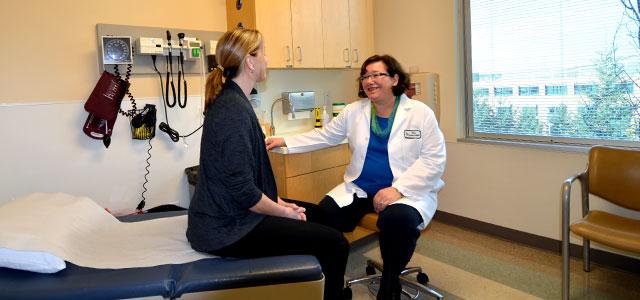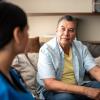
Pamela Davies in clinic at Seattle Cancer Care Alliance
Embracing the Complexities of Managing Pain
“Early in my career, I was a recovery room nurse at a teaching hospital, and I would see patients come out of big belly surgery just screaming in pain,” says Pamela Davies (MS ’92). “It was heartbreaking – and really difficult to get these patients under good control. I would have discussions with the anesthesia attendings, who would talk about their theories of analgesia with balanced anesthesia.” Davies pauses. “With patients screaming in pain, it was clear that the theories were no good.”
Those moments, difficult as they were, instigated a career in pain management and palliative care in which Davies has brought to her patients countless insights gleaned from working with many of the leading lights in the field of pain and oncology symptom management. Along the way, she has coordinated multiple clinical studies, published articles, presented at conferences and gathered a host of degrees and certifications. Her Compact Clinical Guide to Cancer Pain Management: An Evidence-Based Approach for Nurses, co-authored by Yvonne D’Arcy, was awarded second place in the Palliative Care and Hospice category of the American Journal of Nursing 2013 Book of the Year awards.
Today, Davies is a nurse practitioner at Seattle Cancer Care Alliance (SCCA), the oncology center for the University of Washington, where she assisted in developing and leading an outpatient palliative and supportive care service to “provide complex symptom management and psychosocial support to patients with advanced cancer – and to optimize individual and family care needs in preparation for end of life.”
She also has a passion for educating nurses in the field of pain and palliative care, and is a popular local and national speaker on these topics. A particular interest is the American Association of Colleges of Nursing’s End-of-Life Nursing Education Consortium (ELNEC) – and she began an ELNEC program at SCCA, which is now in its fifth year.
“We have a great crew and have trained over 250 nurses in the essentials of end-of-life care,” she says.
“Pam is really doing some extraordinary work,” says Christine Miaskowski, one of Davies’ early mentors at UC San Francisco School of Nursing.
Trained in the Army
 Pamela Davies Originally from Seattle, Davies says she entered nursing after finding out about the Walter Reed Army Institute of Nursing – a 7-year program, which offered a fully funded college education that meshed with Davies’ long-held interest in health care. She says, “I got a wonderful basic nursing education at the University of Washington and the University of Maryland at Baltimore, with an instant career as an Army nurse.” She spent 11 years in the military, the final two stationed at Letterman Army Medical Center in San Francisco’s Presidio.
Pamela Davies Originally from Seattle, Davies says she entered nursing after finding out about the Walter Reed Army Institute of Nursing – a 7-year program, which offered a fully funded college education that meshed with Davies’ long-held interest in health care. She says, “I got a wonderful basic nursing education at the University of Washington and the University of Maryland at Baltimore, with an instant career as an Army nurse.” She spent 11 years in the military, the final two stationed at Letterman Army Medical Center in San Francisco’s Presidio.
After completing her military service in 1985, Davies found a position at UCSF Medical Center, where she spent much of her first four years in the postanesthesia recovery unit, spending a significant amount of her time managing patients’ pain. She decided to enter the program in physiological nursing at UC San Francisco School of Nursing, with the goal of becoming a clinical nurse specialist (CNS) in acute pain management.
It was during that time that she met Miaskowski, who suggested Davies would benefit from learning more about oncology symptom management. “I took some additional courses, with Chris, and I was so inspired by what she had to say about the role of nursing, the impact of nurses on clinical research, on patients and patient comfort,” says Davies. “I can’t say enough about what she taught me about the art of nursing.”
By the time Davies emerged from the program in 1992, there were few opportunities to assume a CNS role, so Davies stayed in the job she had taken in 1990 in UCSF’s outpatient clinical pain research center. This enabled her to work closely with prominent pain and symptom management researchers, including Miaskowski and Kathleen Puntillo from the School of Nursing, as well as with neurologists Michael Rowbotham and Howard Fields.
Davies coordinated research studies on managing neuropathic pain using antidepressants, opioids and topical and intravenous lidocaine, leading to the development of the first lidocaine patch. At the same time, she earned a certification in advanced practice oncology nursing and was elected president of the Nursing Pain Association for the Bay Area.
Return to Seattle
In 1996, Davies and her husband decided it was time to return to Seattle, where she again found herself doing pain research, this time at the Fred Hutchinson Cancer Research Center. There, researchers were studying the somatic and cognitive side effects of opioids on healthy human subjects. Davies enjoyed the work but longed for a return to direct patient care.
With that in mind, she earned an adult/geriatric nurse practitioner certificate at the University of Washington School of Nursing. She then secured a position at the VA Medical Center in Seattle, where she did primary care for most of the next decade, while also putting in time in a neurology clinic where providers were managing painful peripheral neuropathies and chronic daily headaches.
“I developed such respect for these providers working with people who were both physically sick and often wrestling with psychiatric and addiction issues,” she says. “It was interesting and challenging work.”
Then, in 2006, a position opened at the Seattle Cancer Care Alliance, where Davies at first would split her time between doing complex cancer pain management and providing palliative and supportive care.
The Nexus of Pain and Palliative Care
While pain and palliation are often inextricably bound, the disciplines evolved in different ways, says Davies. “A lot of cancer pain management comes from the palliative care setting, often using escalating doses of opioids for release from suffering. However, in chronic noncancer pain management, which is often anesthesia-based, the focus is on limiting opioid doses, on interventional blocks and on nonpharmacological and alternate treatments.”
Davies, who has had a foot in both worlds, believes that ideally the two approaches are integrated. Particularly with today’s concerns about misuse of opioid prescriptions and addiction, she believes the separation winds up fostering black-and-white thinking, which is problematic for complex patients.
“You can have people with chronic, noncancer pain that need higher doses of opioids, whereas I just got out of a visit with a cancer patient who I had to speak with about restricting opioid use, because he was trying to self-medicate for anxiety and had a history of alcoholism,” she says. “In any setting, even in hospice, we have to think about what is causing pain. [Pain management expert] Betty Ferrell talks about not just looking at the physical, but also the psychological, social and spiritual domains of suffering. If what’s driving the pain report is existential anguish of impending death, no opioid will solve that.”
Working with Dermot Fitzgibbon, an anesthesiologist and cancer pain specialist at the Seattle Cancer Care Alliance pain clinic, has helped Davies understand more deeply how critical it is to figure out the source of the pain. Is it somatic? Visceral? Neuropathic?
“Once you know that, opioids are just one of many tools. Depending on the source of pain, you can draw a big circle, to show slices of the [pain management] pie,” she says. “For cancer pain management, at least a quarter to a half of the treatment pie is going to be from opioids. But there are also anticonvulsants, antidepressants, nonpharmacological modalities like massage or acupuncture. Psychological techniques like relaxation breathing and humor.”
Davies speaks of a patient with renal cell carcinoma whose pain management was proving an enormous challenge. “We kept going up, up, up on opioids, but when we finally got him into inpatient hospice, and he got to speak with chaplaincy and social work…he realized he was freaked out by the fact that he was dying. It allowed us to help him process this anxiety, and he was finally able to come back down on his pain meds. He died with good pain control and without sedation.”
Frustrations and Rewards
Davies believes that there is more knowledge about and models for chronic pain management than many realize. “But the model of health care in the US doesn’t support what needs to be a multidisciplinary approach,” she says. “Successful multidisciplinary pain clinics are shutting down. Insurance will pay for all sorts of blocks and implants but won’t pay for an hourlong therapy session to explore the role of PTSD in driving a chronic pain experience.”
Despite such frustrations, Davies’ embrace of the broad outlook needed to manage pain effectively seems to stem from the same passion that has caused her to embrace the complexities of life as a palliative care nurse practitioner.
“Being a nurse practitioner brings nursing’s holistic approach together with the medical perspective; it’s the best of both worlds,” she says. “And in palliative care, I get to do cancer pain and symptom management, as well as other aspects of helping people cope with their eventual death. Walking with people in the final weeks, months and years of their lives – I love it more than I ever thought I would.”



